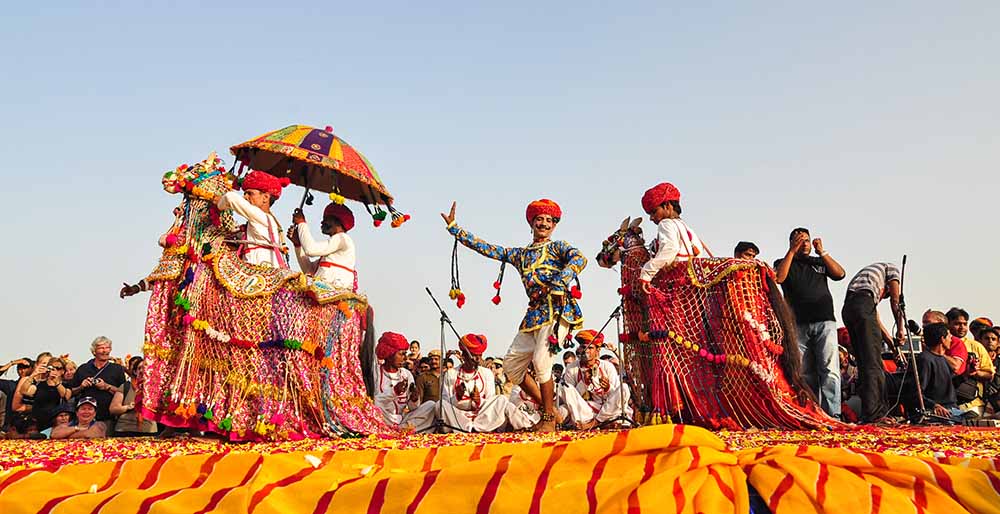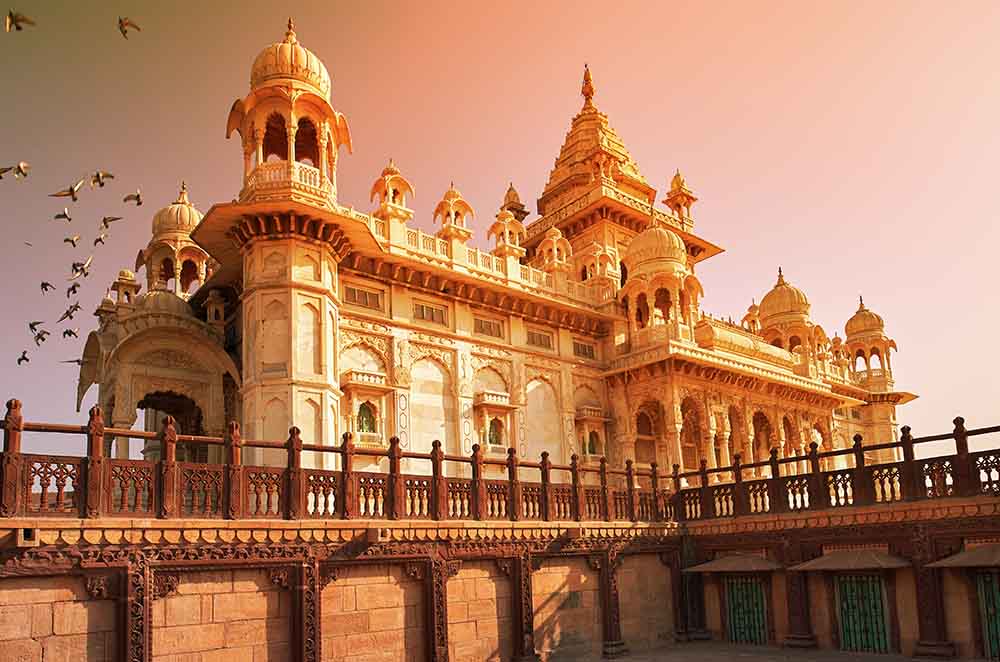Rajasthan means 'Land of Kings'. Typically speaking, Rajasthan had Hindu kings who belonged to the Rajput clan. They lived in Rajasthani cities such as Jodhpur, Pushkar, Jaisalmer, and Udaipur.
The culture of Rajasthan reflects its history mostly through festivals, which are not only religious celebrations but also traditions that mark important dates or occasions in the history of this region. The cultural heritage of Rajasthan is an immense wealth of art and culturally applicable structures.
There are as many as 11 different Indian festivals celebrated in Rajasthan. Apart from this, various festivals are specific to the individual regions and communities within this region. Usually, these celebrations occur at the same time of year but sometimes due to the different times of the day, they can overlap with the other festivals celebrated in other parts of India.
The different festivals in Rajasthan art and culture form an important part of the traditions of Rajasthan and help in reflecting their way of life and history. The very mention of a festival makes one think about how important it is to their society and how much it reflects on the way they live life nowadays.
In some ways, the history and culture of Rajasthan boil down to the following. Pack your bags and get ready to experience Rajasthan
Clothing Styles
For centuries, Rajasthan has been considered the most beautiful region in India. Now, this is true and the entire essence of the culture of Rajasthan is depicted by the traditionally dressed women. They wear jewellery like necklaces, tiaras, and earrings made of precious and semi-precious stones.
The traditional dress style for women in Rajasthan is very famous in their culture and it has made a great impact on other parts of India including North India. Traditional dresses are not just a piece of clothing but an expression of fashion and culture.
The kind of clothes made by women from all over Rajasthan reflects their social status and marital status and also match their social interaction style.
Cuisine
’Sabzi Gharana’ is the term used to describe the food of Rajasthan. This is an old traditional recipe that is prepared by women of every caste and class.
The vegetables used in this recipe are considered a sacred part of food as they are generally grown in the greenest areas. Unfortunately, wild vegetables can't be eaten as they are not suitable for human consumption. Instead, they must be harvested from the cultivated areas.
The dishes prepared from these vegetables are rich in taste and full of health benefits for their consumers with such ingredients as garlic, ginger, and turmeric among many others.
Saffron is another ingredient that has made its way into the traditional cuisine of Rajasthan.
Arts and Crafts
Rajasthani culture largely depends on the different kinds of arts and crafts practiced by the people here.
These arts are preserved as they are handed down from one generation to the next. It's a wide range of crafts that are practiced by the Rajasthani people and it includes embroidery, needlework, beadwork, tie-dyeing, and weaving, among many others.
This aspect of the culture is so prominent that it has been declared an intangible cultural heritage by UNESCO. The arts of Rajasthan are not limited to buildings and temples but also include artifacts like sculptures, and paintings on walls but also in public spaces, forts, and carvings on buildings and temples.

Dance and Music
A very important aspect of the culture of Rajasthan is its music and dance. We can say that without it, Rajasthani culture would not be there at all.
These are the mediums used by people to express themselves and to demonstrate their feelings about their everyday life experiences. The music is played by musicians using different instruments in a particular style, which usually reflects one's situation during a particular time in one's life.
Dancing is done with a specific style but it is mostly done as an expression of happiness or sadness while performing this particular art form.
The different types of dance forms practiced by the Rajasthani have evolved over time.
Architecture
The typical architecture of Rajasthan is a combination of Islamic and Hindu influences. The buildings erected in different parts of Rajasthan use different kinds of materials like wood, marble, stone or bricks depending on the region and climate.
The shrines and temples along with mosques are also an important part of Rajasthani culture, although not to be taken as a religious structure. Rather they should be considered as an art form, which has been passed down to them over generations.
The temples are constructed with sandstone, marble or other stones which are usually grey and can be found all over the walls of ancient buildings and temples.

Festivals
Every year, Rajasthanis celebrate many festivals that they believe to be very sacred and important. . These festivals include Puja of Durga, Bhairo Ji Ambe Dass Ji, and Kartik Purnima.
Durga Puja
It is also called Mahalaya and is an important festival celebrated by women in Rajasthan. It marks the worship of Durga, a Hindu goddess born from a man's head, which is considered to be an avatar. The festival itself is held on a full moon day and women take part in prayers and chanting during this occasion.
Bihu Festival
This festival is celebrated in February and it marks the victory of light over darkness, similar to something that happens on 25 December at Christmas time.
Phool Wali, Rang Panchami and Tija Festival
The festival of Phool Wali is celebrated on the fifth day of the traditional week in February. It marks the celebration of love and hopes for good health with flowers. This is a tradition that has been followed for over 1,000 years.
The Rang Panchami festival is celebrated on the fifth day after Holi when people of Rajasthan celebrate with colours. The Tija Festival is held from 24 February to 1 March where people pay homage to Lakshmi, the Goddess of Wealth and Prosperity.
Bhramanvad (Holy) Season
This festival is held every year from July to August in Rajasthan. It is five days when people participate in a special religious ceremony that includes birth, death, marriage, and renunciation ceremonies.
Dussehra
This festival is celebrated on the tenth day of the bright half of the month Ashvin or Kartik. It marks the victory of good over evil and commemorates the victory of Lord Rama over Ravana.
Religions and Languages
Rajasthan is home to a large number of Hindu temples and it is an important part of their culture as these are usually visited during religious occasions.
Another main religion and cultural influence in the state is Islam, which was introduced by Mughal rulers. This religion has been accepted and practiced by a large number of Rajasthanis and it can be seen in almost all parts of Rajasthan.
The language spoken by the people of Rajasthan throughout the region is Hindi. Different dialects are widely spoken and these include Marwari, Gujarati, Punjabi, Sindhi, and Bagri along with many others that we cannot mention because there are so many.
Conclusion
Rajasthani culture is a very interesting aspect of Indian culture and it has been preserved for many years. This includes its architecture, music, dance and language as these are the media of expression for the people of Rajasthan. These festivals and celebrations are performed as a way to express their feelings about life to their god for his blessings and mercy upon them.
FAQs
What are the various festivals celebrated by Rajasthani people?
Rajasthanis celebrate many festivals in a year. The most popular one among them is the Marwar Festival, which is mainly held in Jodhpur. Other festivals are the Teej, Lohri, and Makar Sankranti.
What are some famous Rajasthani dances?
The popular dance forms practiced by Rajasthanis include Garba, Dandiya Raas, Dhangar, and Kandia Raas.
Is the Rajasthan culture attractive and inviting?
The Rajasthan culture as a whole is very inviting and intriguing to experience.